Sometimes we get so used to doing things the way that we first learned them that we forget about all the other options available.
I had always boiled water on a miniature gas stove when I was camping, and I still remember the fascination and amazement that I experienced when I saw somebody using a Jetboil on the trail.
“What an awesome new invention!” I shouted cheerily to a bemused backpacker, who had been using them for over 17 years.
In case you need a refresher on some smart and easy ways to boil water for your next camping trip, this article will give you 15 ideas.
1. Car Kettle
Car kettles used to be pretty junky bits of kit that were more of a novelty than anything else. But the technology has advanced in leaps and bounds, so now they are a perfectly sensible way to boil water while you are camping.
They are perfect if you are car camping in the winter and don’t want to face the freezing weather outside.
Car kettles are also great if you are “stealth camping,” as you don’t have to get out and start making your morning cup of coffee in a public carpark if you stopped off for a cheeky night’s rest on the way to your destination.
Just bear in mind that they take much longer to boil than a typical electric kettle. Even the newer ones might take 20 minutes to boil a cup of water.
But so long as you remember to start preparing your water before you need it, they are a good choice for vehicle campers.
2. Campfire
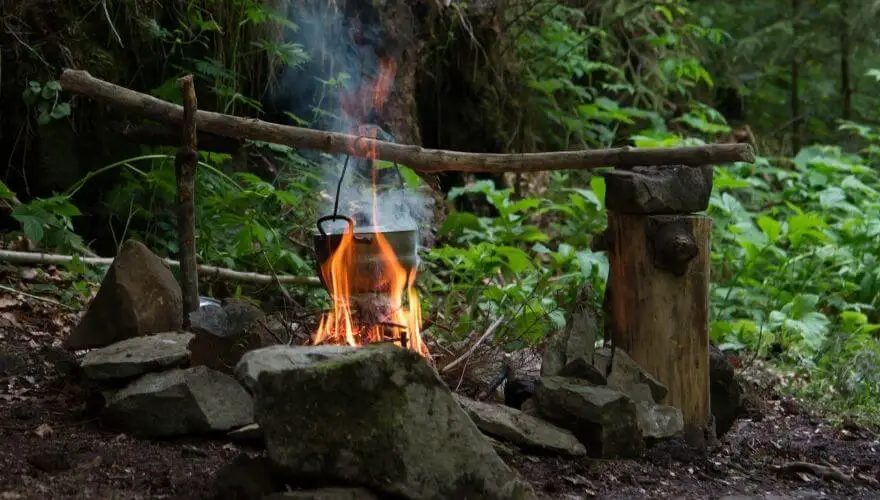
I love a good campfire, but I used to boil my water on a gas stove right next to the crackling flames without realizing what a wasted opportunity that was!
You can boil water on a campfire by either building a platform on the fire or using a tripod to hang your pans from. The tripod method would be easier, but it would also be more expensive.
People build a platform from either wood or stones. I would go for stones because you don’t have to worry about the platform burning up and toppling over before your water is ready.
Remember to create the platform before you ignite the fire. You can always pop a metal grill sheet between two rocks to make a flatter surface.
Note: Make sure your cooking equipment doesn’t have any plastic, silicone, or wooden pieces that will burn or melt!
3. Rocks
Another way to boil water is to put stones into your campfire for a good 30 minutes, then use tongs to put the hot rocks into a pan or bucket of water.
You can use sticks instead of tongs if that’s all you have available, but note that the water won’t taste great if you do it this way.
This method is typically used in bushcraft education or survival situations because most people don’t want bits of ash floating in their coffee.
4. Barbecue
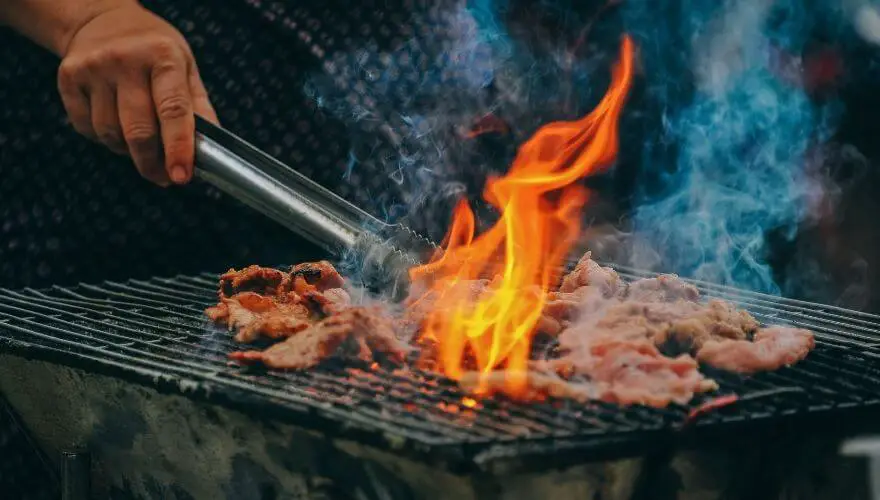
You can boil water on a barbecue! I think the best way to do this would be to wait until your charcoal has burned down nice and hot.
You can use a stick or metal poker to create a little “nest” in the hot coals, then pop your cooking vessel and water in the depression.
Be sure to use cooking vessels that won’t melt on you. Also, you’ll probably need a good, thick oven mitt so that you can safely remove your pan from the coals.
You can get pans with detachable handles that can be good for this situation.
5. Jetboil

Ah, the famous Jetboil! These are fabulous, compact water boilers that use minimal gas. They are great for windy situations because the flame is protected, and they can boil water in less than two minutes!
You can get cheaper copycat versions of the Jetboil these days, and many of them hold their own.
When I’m eating dehydrated ration packs for a backpacking trip, this kind of cooking system is my number one choice for boiling water. I just wish I’d discovered them sooner.
6. Mini Stove
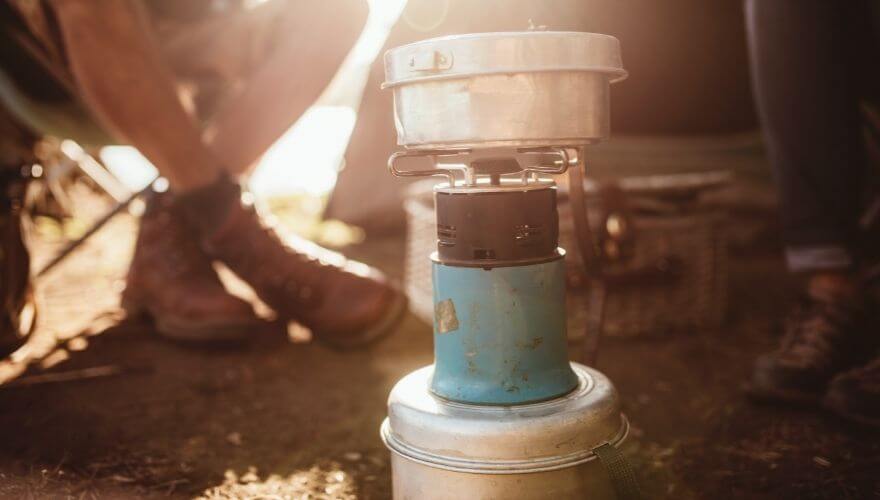
That’s not to knock a good old-fashioned gas burner. I honestly think that a pocket-sized propane stove is the best choice for most campers. You can boil water reasonably quickly and easily, and they aren’t expensive or too heavy for your pack.
It is a bit annoying that you have to supervise these little stoves constantly, as they aren’t stable enough to be left alone. (I can’t tell you how many times I’ve looked away for a minute only to find that my hot water got dumped out on the grass!)
Make sure you have the correct fuel canister for your stove, as some of them are twist-ins while others click into place. You can easily end up with gas and a stove that aren’t compatible, which will do you no good on a mountainside.
7. Alcohol Stove
I haven’t used an alcohol stove in about 10 years, but they do have their benefits. These stoves are lightweight, and the fuel is readily available.
If you were backpacking and camping abroad, these would be a good option, as the fuel is more likely to be available on other continents.
I also like that alcohol stoves are better for the environment because the process of creating the fuel is less polluting.
If your propane stove doesn’t light quickly enough, you can release quite a bit of gas into the space around you, which will blow up into a large flame for a second before the gas gets used up.
But you don’t have this risk with alcohol stoves because you pour the liquid fuel into a dish to light it.
8. Flameless Ration Heater
If you want to boil water to cook your ration pack, you might want to consider a flameless ration heater.
These are more expensive than regular ration packs, and soldiers frequently use them out in the field. (You don’t want to give away your position by lighting a fire!)
Typically, you have to add water to an included sachet of powder, which starts the heating process. It takes around 12 minutes for the meals to heat up, and they are lightweight and calorific.
I’d recommend these for people doing long-distance thru-hikes in cold conditions.
9. Solar Ovens
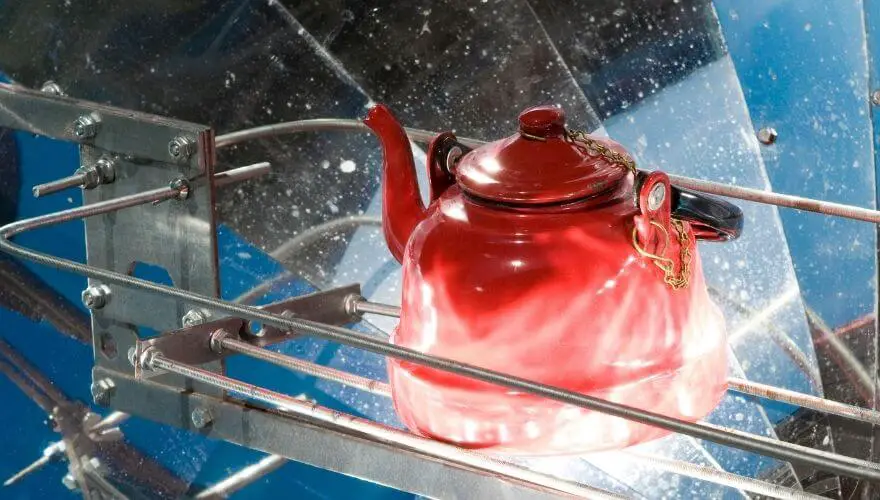
In the right conditions, you could boil water in a solar oven. These are great because you don’t have to worry about refueling, but you do need to be in a suitably hot and sunny climate for them to work effectively.
You could also use a solar water heater to warm up your water. I use a simple solar bag with a nozzle to take warm showers when I’m off-grid.
These can be an effective way to heat your water, but I’ve never been able to get my water to boiling point this way (and I wouldn’t want to ... ouch!).
Solar ovens wouldn’t be suitable for overcast or rainy days, which is when you need your boiling water the most.
10. Commercial Water Boiler
If you’re camping with a large group, you might want to consider getting a large water boiler that you’d typically see at a conference.
This can be a great way to free up space around the cooking stove, and people can just pop up and take hot water as they need it.
You’d need access to mains electricity for these to work effectively, so they might not be the best for every situation.
11. Microwave
This might sound silly, but I have stayed at campsites with microwaves available in the kitchen area. (But not a kettle, weirdly!)
If you’re running low on fuel, it’s worth knowing that you can use a microwave to prepare water for a cup of tea or coffee.
Obviously, you need to make sure that your bowl or cup is oven-safe; then you can microwave the water in one-minute blasts until it’s hot enough. It usually takes only a couple of minutes!
12. Gas Burner
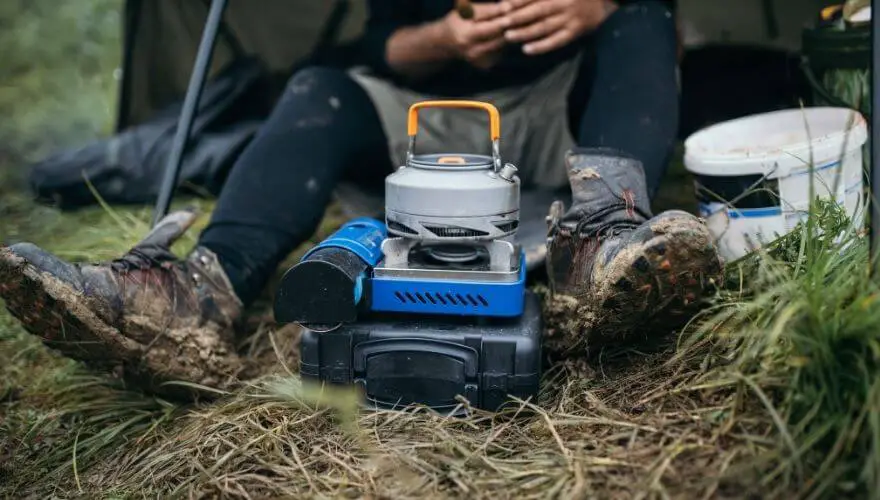
I already mentioned pocket stoves, which a lot of backpackers use. But if you’re car camping, there’s no reason to be crouching around something so unstable just to boil your water.
You can get a decent gas stove with two burners pretty inexpensively. This makes it much easier to cook a decent meal, plus you don’t have to cling to the panhandle the entire time you’re cooking.
Survival Situations
These next three ideas probably aren’t the most convenient for a typical camping trip, but if you found yourself in a survival situation, they would be pretty useful!
Don’t forget that boiling water isn’t necessary just for making a cup of morning coffee. It can also mean the difference between life and death if you’ve collected river water and want to kill off any pests and pathogens before drinking it.
13. Battery
In a tight spot, you can start a campfire with a battery and a piece of foil (like chewing gum foil). It’s straightforward to do, and it won’t take up much space in your pack. (Then again, you might as well just bring matches if you’re bringing anything!)
I think this trick is pretty cool anyway, so here is a little video explaining it in more detail.vi
14. Water Bottle
Most people know that you can start a fire with a magnifying glass. But you can use the same principles to start a fire with a plastic water bottle, too!
Once you get a fire going with your battery or bottle, you can use it to boil water using the campfire or hot stone techniques I described earlier.
Here’s another little video to explain how that would work:
15. Tin Can
Let’s say you’ve managed to light your fire with your water bottle or battery. How are you going to boil your water if you don’t have cooking equipment?
One option is to get your hands on an old tin can. (For the first time ever, you’ll find yourself wishing that more people littered.)
You would be better off boiling water in a metal canteen, as a load of BPA can come through the can. (Better than dying of cholera or something similar, though!)
Final Thoughts
There are so many ways to boil water while camping, but there’s no need to overcomplicate things. The best option for campers is probably a Jetboil, but an alcohol stove or small gas burner would also do just fine.
Boiling your water on a campfire can be a therapeutic experience, but it can be easier to just go for a nice, big gas stove if you’re car camping and you have the space.
By all means, light your fire with a battery or plastic water bottle if you’re feeling inspired. But it would likely be simpler to do something a little more boring and conventional.
I hope you found this article helpful, and I wish you many happy camping adventures!
More to Read:

Rachel Horne
Rachel is a freelance adventure writer and founder of Highly Sensitive Nomad. When she isn’t writing, she can be found wild camping in the mountains and swimming in the lakes of Europe.


